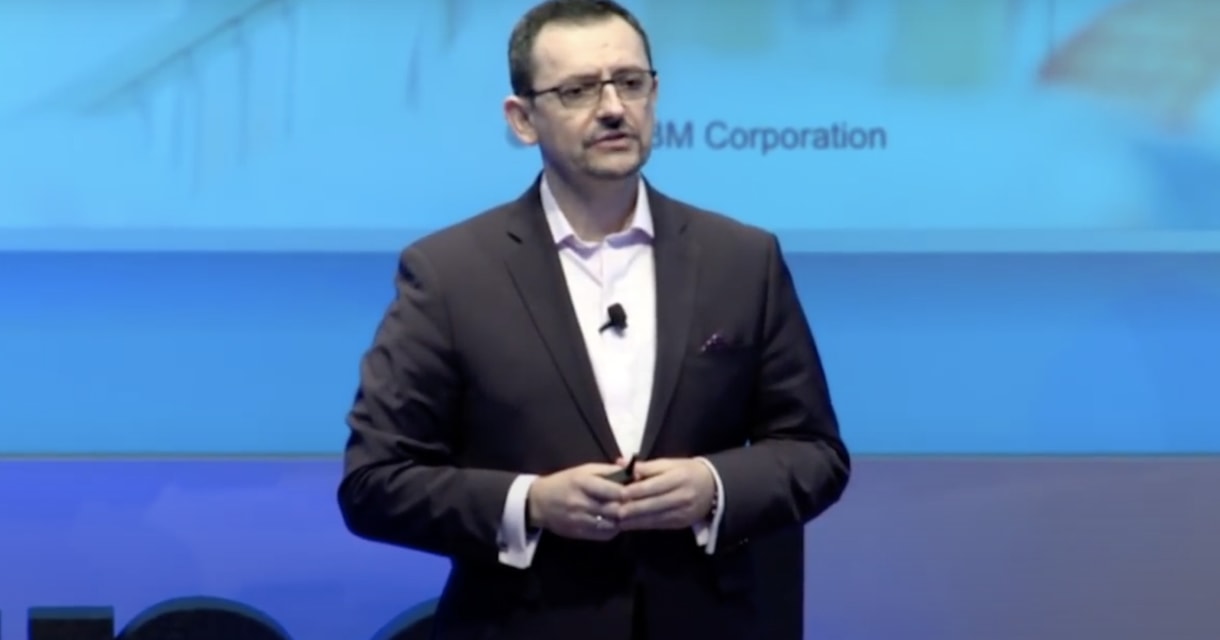Jesus Mantas is the global leader of Strategy and Offerings at IBM Global Business Services (GBS), a $17 billion-dollar unit of IBM. He leads GBS’ strategy, M&A, cognitive asset development, commercialization, and thought leadership functions; he is responsible for driving innovation in GBS offerings and services to create sustainable value for clients.
Recently, Jesus established GBS Ventures to expand client joint-ventures, develop GBS ecosystems and enhance internal innovation efficiency.
Recently, Jesus established GBS Ventures to expand client joint-ventures, develop GBS ecosystems and enhance internal innovation efficiency.
Jesus is a member of GBS’ Global Operating and Global Executive Teams, IBM’s Acceleration team and co-chairs the IBM Hispanic diversity council. He is passionate about technology education, leadership development, diversity and inclusion, and the development of learning agility to enable clients and organizations to reinvent themselves.
Jesus joins TWIN as part of two panels this Wednesday: Incumbents Strike Back at 10:40 am, and Making AI work for Business… and Human Beings at 2:00 pm.
Jesus joins TWIN as part of two panels this Wednesday: Incumbents Strike Back at 10:40 am, and Making AI work for Business… and Human Beings at 2:00 pm.
Bryan Campen: Just so that I get my head around this, and I think I know but want to make sure.… You mention in a recent piece for the World Economic Forum, Why artificial intelligence is learning emotional intelligence, that you created a small practice to infuse design into the business-to-business process at IBM, and you are in fact also the head of strategy at IBM Global Business Services. Could you just describe what you’re doing at IBM? I know you’re heading up strategy and all sorts of other work but how would you describe what you do?
Jesus Mantas: Yes, I lead global strategy, offerings, software assets, M&A and thought leadership for the $17 billion unit of IBM that is focused on business services. On strategy, that means both the operational and the three- to five-year planning of the business; on offerings, it means defining how we package our capabilities to be offered to clients; on software assets, I am responsible for enhancing our services with software and data and provide platforms that add faster and more scalable value to clients.
Jesus Mantas: Yes, I lead global strategy, offerings, software assets, M&A and thought leadership for the $17 billion unit of IBM that is focused on business services. On strategy, that means both the operational and the three- to five-year planning of the business; on offerings, it means defining how we package our capabilities to be offered to clients; on software assets, I am responsible for enhancing our services with software and data and provide platforms that add faster and more scalable value to clients.
I also lead, as part of our strategy, the M&A programs, including ventures, which are the different ways to engage with clients and ecosystem partners. Finally, I lead the IBM Institute for Business Value, the thought leadership arm of IBM that surveys tens of thousands of C-suite members and publishes over 100 reports annually across every industry.
This year, I also lead a high priority program to develop artificial intelligence skills at scale for the IBM company — what we call IBM AI Academy. I have maintained for a long time that the number one priority around artificial intelligence is all about skills. Adopting AI is not a technology challenge, it is a skills challenge, and now I am working to solve it.
This year, I also lead a high priority program to develop artificial intelligence skills at scale for the IBM company — what we call IBM AI Academy. I have maintained for a long time that the number one priority around artificial intelligence is all about skills. Adopting AI is not a technology challenge, it is a skills challenge, and now I am working to solve it.
BC: How do you articulate what’s happening with artificial intelligence at IBM?
JM: At IBM, we are crisply focused on enterprise AI, artificial intelligence for the enterprise world. That is different in many respects from artificial intelligence used in the consumer world. From the point of view of trust, for example: if the AI in your phone makes a mistake and doesn’t detect a face, or misclassifies a picture, it’s not an issue; similarly, it’s less relevant the lineage of the data used to train that engine to recognize faces than —
JM: At IBM, we are crisply focused on enterprise AI, artificial intelligence for the enterprise world. That is different in many respects from artificial intelligence used in the consumer world. From the point of view of trust, for example: if the AI in your phone makes a mistake and doesn’t detect a face, or misclassifies a picture, it’s not an issue; similarly, it’s less relevant the lineage of the data used to train that engine to recognize faces than —
for instance — who trains an enterprise system to detect compliance issues, or security threats. In the enterprise world, who trained these AI systems, with which data and for what purpose are very important points.
Much of what’s being discussed now related to these points of trust and transparency in AI for meaningful enterprise purposes. In IBM, our principles of trust, transparency and ethics are translated into our products and services with the clear purpose to augment human capabilities in every profession, in a responsible manner.
Much of what’s being discussed now related to these points of trust and transparency in AI for meaningful enterprise purposes. In IBM, our principles of trust, transparency and ethics are translated into our products and services with the clear purpose to augment human capabilities in every profession, in a responsible manner.
BC: Right, and that’s what you state as your purpose, correct? To augment the human being, the professional, the worker.
JM: Exactly. We are focused on using artificial intelligence to augment the capabilities of humans, not to replace them. And to make sure that we and our clients build AI skills at every level, not only technical skills, but also skills to “apply AI” to every function of the business. As I said the main constraint for adoption will be availability of people that are skilled in the application of AI technology to transform tasks and functions in their professions.
JM: Exactly. We are focused on using artificial intelligence to augment the capabilities of humans, not to replace them. And to make sure that we and our clients build AI skills at every level, not only technical skills, but also skills to “apply AI” to every function of the business. As I said the main constraint for adoption will be availability of people that are skilled in the application of AI technology to transform tasks and functions in their professions.
BC: What do you mean when you say “a constraint of AI skills”?
JM: There will be more demand for people who understand artificial intelligence and know how to apply that than the actual people you can find. That constraint is what I meant. For the next three to five years, companies will need more skills than what they can find.
JM: There will be more demand for people who understand artificial intelligence and know how to apply that than the actual people you can find. That constraint is what I meant. For the next three to five years, companies will need more skills than what they can find.
BC: You talk about the incumbents striking back, and as I was listening to the radio yesterday, there was a well-known science and media personality making the case, as he often does, that the Apollo program and things like the Apollo program are better-suited to larger entities such as NASA, rather than space startups. When you’re doing hyper-ambitious deep space exploration, so the argument goes, it’s better suited to NASA. When it comes to artificial intelligence, does the same rule of scale apply between large corporations and smaller startups?
JM: Being currently at a large corporation, I would never dispute that. [laughter] We definitely think so. You would expect us to think so. One, because we put more money and more time on this technology than small companies do.
JM: Being currently at a large corporation, I would never dispute that. [laughter] We definitely think so. You would expect us to think so. One, because we put more money and more time on this technology than small companies do.
And two, our singular focus is definitely for enterprise use of artificial intelligence. We believe what you just said and we believe we have provided plenty of evidence, in everything we do. We are better suited to provide trusted AI that will actually work for the enterprises around the world. That’s our mission, that’s what we do. Beyond us as a corporation, we believe that the incumbents come back based on also how AI works: AI is an engine that does not work without fuel, and that fuel is data. Incumbents happen to have most of the relevant enterprise data in the world, and they are starting to learn how to use it.
At the beginning of the digitalization cycle, agility was very important, especially from digital natives. They know how to be digital, they know how to think data and they are very fast. But increasingly, once you teach the incumbents to become digital and to think data first — and they actually do have the data, some incumbents are saying “Hey, wait a minute.
At the beginning of the digitalization cycle, agility was very important, especially from digital natives. They know how to be digital, they know how to think data and they are very fast. But increasingly, once you teach the incumbents to become digital and to think data first — and they actually do have the data, some incumbents are saying “Hey, wait a minute.
We’re actually getting good at this. We are starting to know how to innovate. We’re starting to know how to be agile. We have data that we’ve never monetized! Now we have these great tools to actually enhance the value we can give to our clients and employees.” and that’s just a better formula for success than the other alternative, which is for digital natives to learn the industry and build decades of relationships and know how, some may succeed, but it’s a low odds bet: They know a lot about digital but they need to learn how to be a bank or an insurance company, and establish themselves as a trusted brand in that industry, and it’s not that easy.
So that’s our hypothesis on incumbents striking back. I think we woke up the world last year when we came up with this provocative title to the study.
It is validated almost every day by many of our clients. Of course, our role has been to help them getting to this next set of behaviors, next set of disciplines, next set of skills to be able to digitally transform. Their coming up with meaningful, impactful ways to use AI and other digital technology and leverage their knowledge and position in their industries. Their experience becomes an advantage, not a liability.
It is validated almost every day by many of our clients. Of course, our role has been to help them getting to this next set of behaviors, next set of disciplines, next set of skills to be able to digitally transform. Their coming up with meaningful, impactful ways to use AI and other digital technology and leverage their knowledge and position in their industries. Their experience becomes an advantage, not a liability.
BC: I have two other questions in that vein, one on privacy and one on experience design. With regard to privacy, there’s almost a sense of inevitability in the air, that because of social networks’ rapid adoption, that privacy and data issues are dead and current attempts to stem the tide through policy is an antiquated approach. That argument is constantly made, at least in US markets. It almost is treated like an inevitability that privacy is sort of passé. Why does privacy matter at all, and do you sense and think that the pendulum is swinging back the other way?
JM: We’ve been pretty constant on this point in IBM, that our clients’ data is theirs. The insights we help our clients obtain with their data are theirs. We do think people have the right to own their data, own their insights, and if someone is going to be using it for a different purpose, they should understand what that purpose is. Our business model is not to aggregate and extract value from our clients’ data. We understand it is the business model of others, but not ours. We just don’t subscribe to that. I think frankly, that the world is waking up to be sensitivity to this point where people maybe before, either were unaware or unaware of the consequences. I think the debate is on and it’s going be on for a while. The more people understand the value of their data, the more that they will worry, for what purposes their data is going to be used.
BC:With experience design, how do you design for AI so that humans can keep pace with the force of AI and the insights that they’re surfacing and the data that they’re able to manage? How do AI and people best mesh together?
JM:I personally have passion for this topic. Most of the issues with adoption of new technology is not about the actual capability of the technology: It is the resistance to change behaviors needed in humans to adopt it. Experience design provides a better path for that resistance to be minimized or eliminated. I personally have been focused on understanding human behavioral drivers with neuroscience, and combine that with experience design.
People may not realize how much we have learned about how our own behavioral drivers work with neuroscience, probably we have learned more in the last 18 years than the prior 100 years of psychology, because of how much better we can actually look inside of our brains with the functional MRI.
JM:I personally have passion for this topic. Most of the issues with adoption of new technology is not about the actual capability of the technology: It is the resistance to change behaviors needed in humans to adopt it. Experience design provides a better path for that resistance to be minimized or eliminated. I personally have been focused on understanding human behavioral drivers with neuroscience, and combine that with experience design.
People may not realize how much we have learned about how our own behavioral drivers work with neuroscience, probably we have learned more in the last 18 years than the prior 100 years of psychology, because of how much better we can actually look inside of our brains with the functional MRI.
A simple example: We now understand that social pain and physical pain are physically in the same areas of the brain, and trigger similar behaviors of similar intensity and relevance. We may have not understood that before but now we understand it. We understand the issues of capacity motivation and bias better than we have ever before. We understand what the different between conscious and unconscious bias is and therefore, we are able to better design for that. All of those things that enable us to reverse engineering human psychology — are translatable directly to designing services that trigger positive reinforcement and therefore result in faster adoption of technology and change, as a pace and level of change management impossible to achieve before.
JM: Of course, one of the masters of this was Apple in the consumer world —they are in the business of designing technology that from its inception inspires confidence, not fear, in the user.
BC: Right, the classic example being the friendly-faced Apple IIe.
JM: Exactly. I recently read that when Steve Jobs returned to Apple, he insisted on spending much more than competitors on design and manufacturing features in products that appeared useless — for instance, he included a handle in one of the iMacs even though the product was not portable). In the article, it described that the purpose of the handle on a non-portable product was to unconsciously create in the human psychology a “permission to touch”, and in doing so, lower the potential resistance of people to use technology due to fear. Jobs knew the importance of that.
BC: Right, the classic example being the friendly-faced Apple IIe.
JM: Exactly. I recently read that when Steve Jobs returned to Apple, he insisted on spending much more than competitors on design and manufacturing features in products that appeared useless — for instance, he included a handle in one of the iMacs even though the product was not portable). In the article, it described that the purpose of the handle on a non-portable product was to unconsciously create in the human psychology a “permission to touch”, and in doing so, lower the potential resistance of people to use technology due to fear. Jobs knew the importance of that.
It made the technology less of a feared object.
In a way, I take all these elements —design, neuroscience, process reengineering — and I combine them to help clients digitally transform by placing more emphasis on content design, design language, and empathy-mapping, to accelerate adoption and new behaviors. I believe, in some cases, that experience design becomes more important than the actual underlying technology. If you don’t get that right, it doesn’t matter how good the technology’s going to be.
In a way, I take all these elements —design, neuroscience, process reengineering — and I combine them to help clients digitally transform by placing more emphasis on content design, design language, and empathy-mapping, to accelerate adoption and new behaviors. I believe, in some cases, that experience design becomes more important than the actual underlying technology. If you don’t get that right, it doesn’t matter how good the technology’s going to be.
BC: Has there been any direct collaboration between IBM and Apple when it comes to experience design?
JM: Five years ago, IBM and Apple entered into a partnership to figure out how we take that essence, that ability Apple had to transform behaviors in consumers, and jointly apply it to transform professions and industries. And in a way, we learned a lot from each other. I think Apple learned from IBM what matters to the enterprise. IBM learned from Apple that experience design really matters in every aspect of its services.
JM: Five years ago, IBM and Apple entered into a partnership to figure out how we take that essence, that ability Apple had to transform behaviors in consumers, and jointly apply it to transform professions and industries. And in a way, we learned a lot from each other. I think Apple learned from IBM what matters to the enterprise. IBM learned from Apple that experience design really matters in every aspect of its services.
BC: So what’s the outcome of embedding experience design into AI?
JM: AI has become one more tool that we can use in the experience design, with the interesting addition that AI as a technology is more moldable than other technologies that have come before it. The prior technologies were rigid in the sense of… change management was all about teaching the human what to do with the technology. AI allows you to also flip the roles, and teach the technology to interact in ways that makes humans more comfortable engaging AI systems to help them in tasks. It’s still that combination of the technology and the human, that creates the advantages, not one’s replacing the other. At least, that’s not what we intend to do.
JM: AI has become one more tool that we can use in the experience design, with the interesting addition that AI as a technology is more moldable than other technologies that have come before it. The prior technologies were rigid in the sense of… change management was all about teaching the human what to do with the technology. AI allows you to also flip the roles, and teach the technology to interact in ways that makes humans more comfortable engaging AI systems to help them in tasks. It’s still that combination of the technology and the human, that creates the advantages, not one’s replacing the other. At least, that’s not what we intend to do.
BC: You gave a talk called ‘Superhuman’, about superpowers and AI recently, and covered a few superpowers that now, sort of, exist with AI. What is a super power that does not exist that you look forward to existing in the coming five to ten years?
JM: I don’t know, maybe wireless eating. [laughter] If I must pick a super power, it would be telepathy – the ability to communicate brain-to-brain complex concepts:
JM: I don’t know, maybe wireless eating. [laughter] If I must pick a super power, it would be telepathy – the ability to communicate brain-to-brain complex concepts:
it would eliminate the need to translate complex concepts into what is a fairly limited linear mechanism (written language) and exponentially expand human ability to learn and understand at unprecedented speed – imagine a telepathic school that would teach a year of math in a day. Of course we still need to figure how to then absorb and retain all that knowledge, but we’ll tackle that after we have figured out the superpower. [laughter].



